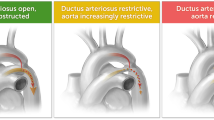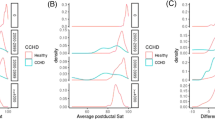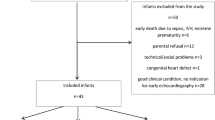Abstract
Objective:
Fetal echocardiography, physical examination and pulse oximetry detect only half of coarctation of aorta (CoA) cases. We aimed to quantify delayed arrival and diminished amplitude of lower extremity photoplethysmographic (PPG) pulses relative to the right hand in affected patients.
Study design:
We studied 8 CoA infants and 32 healthy controls. The pulse arrival time difference between foot and hand (f-hTD) and pulse amplitude ratio (F/H) were measured on PPG signal waveforms by digitally-determining maxima and minima of systolic decrease of light transmission. Mann–Whitney test was used for group comparisons.
Results:
In comparison to healthy newborns, CoA infants’ PPG waveforms demonstrated prolonged f-hTD (mean±s.d. of 73.2±26.6 versus 35.2±8.3 ms, P<0.001) and lower F/H (0.57±0.26 versus 0.99±0.58, P=0.014).
Conclusions:
F-hTD and F/H are quantifiable from hand- and foot-derived PPG waveforms and are significantly different in CoA versus healthy newborns. Larger studies are needed to validate PPG for improved critical congenital heart disease screening.
This is a preview of subscription content, access via your institution
Access options
Subscribe to this journal
Receive 12 print issues and online access
$259.00 per year
only $21.58 per issue
Buy this article
- Purchase on Springer Link
- Instant access to full article PDF
Prices may be subject to local taxes which are calculated during checkout



Similar content being viewed by others
References
Mahle WT, Newburger JW, Matherne GP, Smith FC, Hoke TR, Koppel R et al. Role of pulse oximetry in examining newborns for congenital heart disease: a scientific statement from the American Heart Association and American Academy of Pediatrics. Circulation 2009; 120 (5): 447–458.
Thangaratinam S, Brown K, Zamora J, Khan KS, Ewer AK . Pulse oximetry screening for critical congenital heart defects in asymptomatic newborn babies: a systematic review and meta-analysis. Lancet 2012; 379 (9835): 2459–2564.
Kemper AR, Mahle WT, Martin GR, Cooley WC, Kumar P, Morrow WR et al. Strategies for implementing screening for critical congenital heart disease. Pediatrics 2011; 128 (5): e1259–e1267.
Mahle WT, Martin GR, Beekman RH, Morrow WR, Rosenthal GL, Snyder CS et al. Endorsement of health and human services recommendation for pulse oximetry screening for critical congenital heart disease. Pediatrics 2012; 129 (1): 190–192.
Prudhoe S, Abu-Harb M, Richmond S, WC . Neonatal screening for critical cardiovascular anomalies using pulse oximetry. Arch Dis Childhood Fetal Neonatal Ed 2013; 0: 1–5.
Reller MD, Strickland MJ, Riehle-Colarusso T, Mahle WT, Correa A . Prevalence of congenital heart defects in metropolitan Atlanta, 1998–2005. J Pediatr 2008; 153 (6): 807–813.
Punukollu M, Harnden A . Easily missed? Coarctation of the aorta in the newborn. Br Med J 2011; 343: 6838.
Granelli A de-W, Östman-Smith I . Noninvasive peripheral perfusion index as a possible tool for screening for critical left heart obstruction. Acta Pædiatr 2007; 96 (10): 1455–1459.
Ward KE, Pryor RW, Matson JR, Razook JD, Thompson WM, Elkins RC . Delayed detection of coarctation in infancy: implications for timing of newborn follow-up. Pediatrics 1990; 86 (6): 972–976.
Beekman RH . Coarctation of the aorta. In: Allen HD, Gutgesell HP, Clark EB et al (eds).Moss and Adams’ Heart Disease in Infants, Children and Adolescents, 6th edn. Lippincott, Williams & Wilkins: Philadelphia, PA, 2001.
Goldman M, Schroeder H . Coarctation of the aorta; photo-electric plethysmography and direct arterial blood pressure measurement as an aid in diagnosis. Am J Med 1949; 7 (4): 454–463.
Douglas G, Nicol F, RC (eds). Macleod’s Clinical Examination, 12th edn. Elsevier Health Sciences: Philadelphia, PA, USA, 1999.
Sahni R . Noninvasive monitoring by photoplethysmography. Clin Perinatol 2012; 39 (3): 573–583.
Sinha IP, Mayell SJ, Halfhide C . Pulse oximetry in children. Arch Dis Child Educ Pract Ed 2014; 99 (3): 117–118.
Nitzan M, Patron A, Glik Z, Weiss A . Automatic noninvasive measurement of systolic blood pressure using photoplethysmography. Biomed Eng Online 2009; 8 (1): 1–8.
Nurnberger J, Dammer S, Opazo Saez A, Philipp T, Schafers RF . Diastolic blood pressure is an important determinant of augmentation index and pulse wave velocity in young, healthy males. J Hum Hypertens 2003; 17 (3): 153–158.
Johnson CA . The speed of the pulse wave in coarctation of the aorta. J Lab Clin Med 1950; 36: 842.
Lewis T . Material relating to coarctation of the aorta of the adult type. Heart 1933; 16: 205–261.
Crossland DS, Furness JC, Abu-Harb M, Sadagopan SN, Wren C . Variability of four limb blood pressure in normal neonates. Arch Dis Child Fetal Neonatal Ed 2004; 89 (4): F325–F327.
Boelke KL, Hokanson JS . Blood pressure screening for critical congenital heart disease in neonates. Pediatr Cardiol 2014; 35 (8): 1349–1355.
Chang R, Gurvitz M, Rodriguez S . Missed diagnosis of critical congenital heart disease. Arch Pediatr Adolesc Med 2008; 162 (10): 969–974.
Liberman RF, Getz KD, Lin AE, Higgins CA, Sekhavat S, Markenson GR et al. Delayed diagnosis of critical congenital heart defects: trends and associated factors. Pediatrics 2014; 134: e373–e381.
Mouledoux J, Walsh W . Evaluating the diagnostic gap: statewide incidence of undiagnosed critical congenital heart disease before newborn screening with pulse oximetry. Pediatr Cardiol 2013; 34 (7): 1680–1686.
Ailes EC, Gilboa SM, Honein M a, Oster ME . Estimated number of infants detected and missed by critical congenital heart defect screening. Pediatrics 2015; 135 (6): 1000–1008.
Lannering K, Bartos M, Mellander M . Late diagnosis of coarctation despite prenatal ultrasound and postnatal pulse oximetry. Pediatrics 2015; 136 (2): e406–e412.
Aamir T, Kruse L, Ezeakudo O . Delayed diagnosis of critical congenital cardiovascular malformations (CCVM) and pulse oximetry screening of newborns. Acta Pædiatr 2007; 96 (8): 1146–1149.
Dawson AL, Cassell CH, Riehle-Colarusso T, Grosse SD, Tanner JP, Kirby RS et al. Factors associated with late detection of critical congenital heart disease in newborns. Pediatrics 2013; 132 (3): e604–e611.
Peterson C, Dawson A, Grosse SD, Riehle-Colarusso T, Olney RS, Tanner JP et al. Hospitalizations, costs, and mortality among infants with critical congenital heart disease: how important is timely detection? Birth Defects Res Part A Clin Mol Teratol 2013; 97 (10): 664–672.
Kao BA, Feit LR, Werner JC . Pulse oximetry as a screen for congenital heart disease in newborns. Pediatr Res 1995; 37 (4): A216.
Singh A, Rasiah SV, Ewer AK . The impact of routine predischarge pulse oximetry screening in a regional neonatal unit. Arch Dis Child Fetal Neonatal Ed 2014; 99 (4): F297–F302.
Zhao Q, Ma X, Ge X, Liu F, Yan W, Wu L et al. Pulse oximetry with clinical assessment to screen for congenital heart disease in neonates in China: a prospective study. Lancet 2014; 384 (9945): 747–754.
Acknowledgements
We would like to thank Cristina Sison, PhD (Biostatistics Unit, The Feinstein Institute for Medical Research, Northwell Health System).
Author information
Authors and Affiliations
Corresponding author
Ethics declarations
Competing interests
The authors declare no conflict of interest.
Rights and permissions
About this article
Cite this article
Palmeri, L., Gradwohl, G., Nitzan, M. et al. Photoplethysmographic waveform characteristics of newborns with coarctation of the aorta. J Perinatol 37, 77–80 (2017). https://doi.org/10.1038/jp.2016.162
Received:
Revised:
Accepted:
Published:
Issue Date:
DOI: https://doi.org/10.1038/jp.2016.162
This article is cited by
-
Arch watch: current approaches and opportunities for improvement
Journal of Perinatology (2024)
-
Inadequacies of hospital-level critical congenital heart disease screening data reports: implications for research and quality efforts
Journal of Perinatology (2021)
-
Using pulse oximetry waveforms to detect coarctation of the aorta
BioMedical Engineering OnLine (2020)
-
A new, short-recorded photoplethysmogram dataset for blood pressure monitoring in China
Scientific Data (2018)



